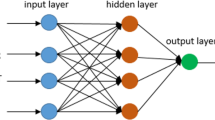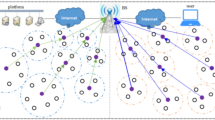Abstract
Wireless Sensor Networks (WSNs) mostly uses static sink to collect data from the sensor nodes randomly deployed in the sensor region. In the static sink based approach, the data packets are flooded across the network to reach the mobile base station in multi-hop communication. Due to this, the static sink is inefficient in energy utilization. Recently, mobile sink are used for data gathering, has less energy utilization which in turn increases the network lifetime. Thus, the sink mobility has difficulties in finding the routing path for the data packets. This paper proposes an effective clustering approach with data aggregation using multiple mobile sinks for heterogeneous WSN. The proposed algorithm achieves network lifetime increases with limited energy utilization.












Similar content being viewed by others
References
Akyildiz, I. F., Su, W., Sankarasubramaniam, Y., & Cayirci, E. (2002). Wireless sensor networks: A survey. Computer Networks, 38, 393–422.
Akkaya, K., & Younis, M. (2005). A survey on routing protocols in wireless sensor networks. Ad Hoc Networks, 3, 325–349.
Heinzelman, W. R., Chandrakasan, A., & Balakrishnan, H. (2000). Energy-efficient communication protocol for wireless sensor networks. In Proceedings of the 33rd annual Hawaii international conference on system sciences, Washington, DC, USA (pp 1–10).
Heinzelman, W. B., Chandrakasan, A. P., & Balakrishnan, H. (2002). An application-specific protocol architecture for wireless microsensor networks. IEEE Transactions on Wireless Communications, 1, 660–670.
Hammoudeh, M., & Newman, R. (2015). Adaptive routing in wireless sensor networks: QoS optimisation for enhanced application performance. Information Fusion, 22, 3–15.
Wang, Z. M., Melachrinoudis, E., & Basagni, S. (2005). Voronoi diagram-based linear programming modeling of wireless sensor networks with a mobile sink. In Proceedings of the IIE annual conference and exposition.
Azad, P., & Sharma, V. (2015). Pareto-optimal clustering scheme using data aggregation for wireless sensor networks. International Journal of Electronics, 102(7), 1165–1176.
Sert, S. A., Bagci, H., & Yazici, A. (2015). MOFCA: Multi-objective fuzzy clustering algorithm for wireless sensor networks. Applied Soft Computing, 30, 151–165.
Mainwaring, A., Polastre, J., Szewczyk, R., Culler, D., & Anderson, J. (2002). Wireless sensor networks for habitat monitoring. In Proceedings of ACM Int’l workshop wireless sensor networks and applications (WSNA).
Kaiser, W. J., Pottie, G. J., Srivastava, M., Sukhatme, G. S., Villasenor, J., & Estrin, D. (2003). Networked infomechanical systems (NIMS) for ambient intelligence, Technical report 31, Center for Embedded Networked Sensing, University of California, Los Angeles.
Khan, M. I., Gansterer, W. N., & Haring, G. (2012). Static vs. mobile sink: The influence of basic parameters on energy efficiency in wireless sensor networks. Computer Communications, 36, 965–978.
Yu, S., Zhang, B., Li, C., & Mouftah, H. T. (2014). Routing protocols for wireless sensor networks with mobile sinks: A survey. IEEE Communications Magazine, 52(7), 150–157.
Kansal, A., Somasundara, A., Jea, D. D., Srivastava, M. B. & Estrin, D. (2004). Intelligent fluid infrastructure for embedded networks. In Proceedings of of the 2nd ACM/USENIX MobiSys.
Jea, D., Somasundara, A., & Srivastava M. B. (2005). Multiple controlled mobile elements (data mules) for data collection in sensor networks. In Proceedings of the 1st IEEE/ACM DCOSS.
Intanagonwiwat, C., Govindan, R., & Estrin, D. (2000). Directed diffusion: A scalable and robust communication paradigm for sensor networks. In MOBICOM (pp. 56–67).
Wichmann, A., & Korkmaz, T. (2015). Smooth path construction and adjustment for multiple mobile sinks in wireless sensor networks. Computer Communications. doi:10.1016/j.comcom.2015.06.001.
Shi, L., Zhang, B. X., Mouftah, H. T., & Ma, J. (2013). DDRP: An efficient data-driven routing protocol for wireless sensor networks with mobile sinks. International Journal of Communication Systems, 26, 1341–1355.
Liu, W., Lu, K. J., Wang, J. P., Xing, G. L., & Huang, L. S. (2012). Performance analysis of wireless sensor networks with mobile sinks. IEEE Transactions on Vehicular Technology, 61, 2777–2788.
Lin, C. J. (2006). HCDD: Hierarchical cluster-based data dissemination in wireless sensor networks with mobile sink. In Proceedings of international conference on wireless communications and mobile computing, Vancouver, Canada (pp. 1189–1194).
Shah, R. C., Roy, S., Jain, S., & Brunette, W. (2003). Data MULEs: Modeling a three-tier architecture for sparse sensor networks. In Proceedings of IEEE workshop sensor network protocols and applications (SNPA).
Konstantopoulos, C., Pantziou, G., Gavalas, D., Mpitziopoulos, A., & Mamalis, B. (2012). A rendezvous-based approach enabling energy-efficient sensory data collection with mobile sinks. Parallel and Distributed Systems, IEEE Transactions on, 23(5), 809–817.
Small, T., & Haas, Z. (2003). The shared wireless infostation model—A new ad hoc networking paradigm (or where there is a whale, there is a way). In Proceedings of ACM MobiHoc.
Heidemann, J., Silva, F., Intanagonwiwat, C., Govindan, R., Estrin, D., & Ganesan, D. (2001). Building efficient wireless sensor networks with low-level naming. In SOSP. Oct 2001.
Intanagonwiwat, C., Estrin, D., Govindan, R., & Heidemann, J. (2001). Impact of network density on data aggregation in wireless sensor networks. Submitted for Publication, ICDCS-22.
Intanagonwiwat, C. Govindan, R., & Estrin, D. (2000). Directed diffusion: A scalable and robust communication paradigm for sensor networks. In MobiCOM, Boston, MA.
Author information
Authors and Affiliations
Corresponding author
Rights and permissions
About this article
Cite this article
Muthu Krishnan, A., Ganesh Kumar, P. An Effective Clustering Approach with Data Aggregation Using Multiple Mobile Sinks for Heterogeneous WSN. Wireless Pers Commun 90, 423–434 (2016). https://doi.org/10.1007/s11277-015-2998-6
Published:
Issue Date:
DOI: https://doi.org/10.1007/s11277-015-2998-6




